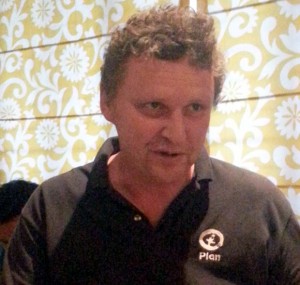
Richard Sandison, Emergency Response Manager for Plan International, believes the pace of rehabilitation in Yolanda devastated areas is going faster than the 2004 Aceh tsunami in Indonesia. He personally headed the relief work in Aceh for two years before working on the Yolanda rehabilitation project of Plan. MATIKAS SANTOS/INQUIRER.net
MANILA, Philippines — Despite many criticisms that the recovery and rehabilitation of areas devastated by Supertyphoon Yolanda (international name:Haiyan), an international non-government organization said that the pace has actually been faster compared to other major disasters in the world.
Richard Sandison, emergency response manager for Plan International’s Emergency Response Unit, compared the first year recovery pace of Yolanda with the 2004 earthquake and tsunami that devastated Aceh province in Indonesia.
He was personally involved in Plan International’s emergency relief and recovery program in Aceh for two years from the tsunami that killed an estimated 170,000 people and destroyed around 500,000 homes.
“I’m very confident to say that the pace of recovery here in the Philippines has been a lot faster than inAceh, and there are various reasons for that,”Sandison said in a media roundtable discussion Friday.
“At the end of year one in Aceh, there was still a hundred thousand people living in tents, but here it’s a lot less. Recent estimates indicate there are just about a thousand people still living in tents,” he said.
The two disasters, however, should not be directly compared given different contexts of the events. For example, Aceh was facing an armed rebellion from a secessionist group which made security a serious problem to address during the rehabilitation process.
Sandison also noted that Yolanda destroyed more homes compared to the tsunami in Aceh because the winds were more widespread across the typhoon unlike the tsunami which devastated more in the coastal areas.
“We’ve learned a lot from Aceh. The slogan “build back better” was created from there. There was much focus on construction there but here the Philippines, [our slogan now is “building back better, stronger, and together,” Sandison said.
“It means working with communities on their recovery journey, involving them as partners in the recovery process, providing emotional support and building knowledge, community spirit, and resilience. These are things that aren’t seen immediately but can withstand any future challenge,” he said.
Carin van der Hor, Country Director of Plan International, said that the recovery pace was fast in some areas but slow in some but in general moving along at a “satisfactory rate.”
“There are some areas where we would want it to be faster. Is it going at a satisfactory rate, I would say so. If I see now where we are one year since Yolanda, its amazing,” van der Hor said.
“When we first saw Tacloban, our initial reaction is that we thought it can’t be fixed. And then we went into recovery mode, and we started fixing and we saw that we can do a lot,” she said.
Plan International has been working for the recovery and rehabilitation of more than 1.3 million survivors throughout the Leyte and Samar provinces, not just Tacloban.
They have so far allocated $61 million for recovery work over three years. They say they need an additional $9.5 million to complete all their rehabilitation projects.